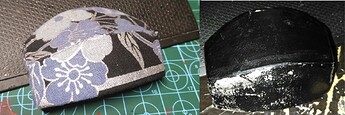The tenjin cover looks quite nice. Congrats!
As for the Doukake itself, if you have not yet glued it, I would like to recommend against wood glue, as it has a tendency to seep through the fabric. I have had great results with 3M Super 77 spray glue, but I recommend you spend several sprays on another surface, just to get the hang of it, as the spray pattern is a vertical strip, longer than you would expect. So you need to practice both speed and distance from the surface to get the best coverage without either thin spots or wet patches.
For applying the fabric, you need to apply it stretching (not just placing), first towards the tips (short side), then towards the long sides. Do the top surface first, then the edges at the short sides, then the edges at the long side (one by one), and then the inside edges. Pay attention to the glue drying time, and also be aware that the glue has a short repositioning time, just in case it didn’t land exactly on the spot you want.
One final tip is, when cutting the fabric, to leave enough fabric beyond the Doukake size, so you have something to grab on to pull. Unfortunately that’s wasted fabric, but unless you have a pair of canvas stretcher pliers hanging around, you need extra fabric to grab on to. I have the canvas stretchers, but I still prefer to stretch with my hands, as that offers more precision and flexibility.
For preservation of color, and protection against dirt/etc, you may want to apply a coating of any protective spray, either a clear matte acrylic varnish (such as those for protecting canvas painting), or the well known scotchgard (but this one needs reapplying every year or so, if you use your Shamisen a lot).
Cheers,


 i find toki to be the best tasting whiskey in my price range so it’s my go-to
i find toki to be the best tasting whiskey in my price range so it’s my go-to